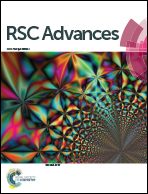Preparation of luminescent graphitic C3N4 NS and their composites with RGO for property controlling
Abstract
Thin graphitic C3N4 nanosheets (g-C3N4 NS) with bright blue photoluminescence were prepared through an acid and alkali corrosion and ultrasonic-assisted method. g-C3N4 NS/reduced graphene oxide (RGO) sample which was prepared through a hydrothermal synthesis offered high separation and transfer efficiency of photogenerated carriers because of the thin g-C3N4 NS attached closely to the RGO. The introduction of RGO sheets provided prominent advantages for enhanced light absorption and promoted the transfer rate of photogenerated carriers from g-C3N4 NS. A g-C3N4 NS/RGO (3 : 2) composite not only functions as a sensor to detect Pb2+ and Cd2+ in an aqueous solution but also exhibits efficient visible-light photocatalytic performance. The application in a sensor is ascribed to the intercalation impact between thin g-C3N4 NS and heavy metal ions. Owing to the presence of more active functional groups (e.g., carboxyl and amino groups) on the surface of the g-C3N4 NS compared with the bulk form, the ions can be easily adsorbed onto g-C3N4 NS. The g-C3N4 NS/RGO composites are highly sensitive and selective in ion sensing, as well as having superior photocatalytic activity.


 Please wait while we load your content...
Please wait while we load your content...